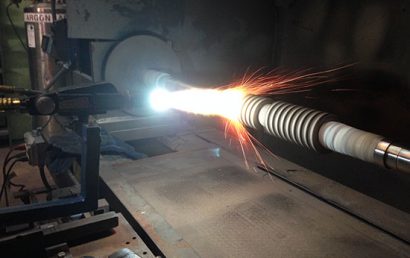What Is Roll Slitting?
The method of cutting a material that presents in a large roll down into rolls that are much narrower calls for a shearing operation known as roll slitting. This type of process is frequently found in the pulp and paper industry. It is essential that the types of machinery and components involved in a process like this be protected against detrimental effects and elements. The proper functionality and efficiency of these parts and components can be greatly affected if they exposed to corrosive or erosive elements and/or excessive wear, friction, or abrasion. In order to provide that protection, thermal spray coatings can be used.
Types Of Roll Slitting
The types of roll slitting differ in a number of manners (i.e., how the material being sheared is treated among others):
Rewind Slitting – here the web (or the material) is unrolled. Eventually, it is formed into narrower rolls and rewound onto one shaft (or more) after passing through a machine which runs it through lasers or knives.
Log Slitting –here, the material in question is treated as a “log” or a whole. Without unrolling and then having to reroll it, a slice (or more) is taken from the material.
Who Uses Roll Slitting?
As previously mentioned, the pulp and paper industry uses roll slitting on a large basis. It is also a technique used heavily in other industries and companies that laminate, coat, and print materials. Food packaging and flexible packaging material companies also use roll slitting.
In the past, there were roll slitter operators whose major responsibility was, not surprisingly, to operate the roll slitter. In these days of high technology, however, the digital age has had a definite effect on roll slitters’ positions of employment. There are now, in existence, automatic slitting machines. The move was made in the interest of, among other things, increased production volume. But whether these machines are operated by a human being or through advanced technology, the parts and components involved still need the same kind of protection that they always have – and it is likely that they always will.
Materials Commonly Sheared by Roll Slitters
Depending on the roll slitter itself, they can be extremely versatile as to what kinds of materials they can handle. Some of the materials that can be sheared or cut by roll slitters are as follows: leather, cork, graphite, fiberglass, felt, rubber, non-wovens, vinyl, fabric, laminates, textiles, films, foils, foams, and even pressure sensitive tapes. Imagine how tricky it must be, and the intricacies involved, in slitting or shearing that last material.
If you are involved in the pulp and paper industry, and you would like to explore the possibility of using protective coatings to protect and improve the efficiency of your roll slitters, call or email A&A Coatings today. We have over 70 years of experience in the field of thermal spray and protective coatings used on everything from roll slitters to winder drums to starch tanks, and everything in between.



